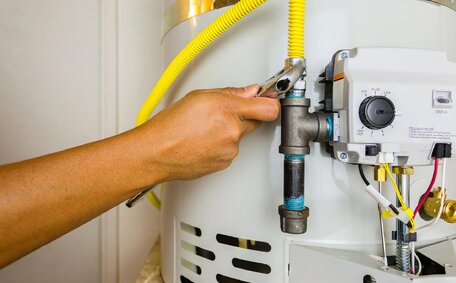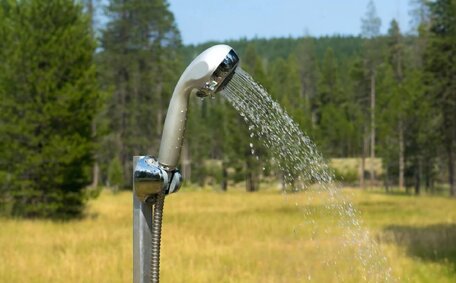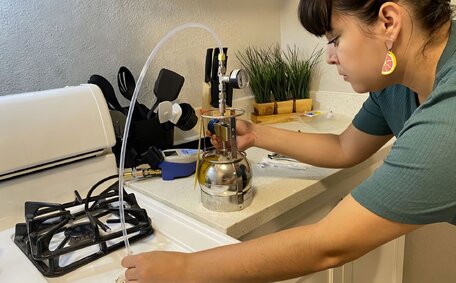Introduction to Septic Tanks and How They Relate to Drain Blockages
Septic tanks are crucial for many household plumbing systems, especially in rural areas without main sewer lines, and can experience backups during issues.
They provide onsite treatment of wastewater by separating solids from liquid waste before the clarified effluent drains into the soil via a series of underground perforated pipes known as leach drains or drain field.
When functioning correctly, heavy wastewater solids settle at the tank’s bottom, where bacteria decompose them. Lighter waste forms scum at the top, breaking down over time. The resulting clear effluent passes through a filter, exits the tank, and naturally filters further as it drains into the soil.
In addition, grit, grease, and foreign objects may accumulate and block the pipes connecting household drains or the leach field.
When sewer drains back up, wastewater may overflow the tank into the ground or back up through the home’s lowest plumbing fixtures.
Foul smells, effluent pooling near the tank, or interior leaks indicate a damaged or overloaded septic system that requires prompt servicing.
Common Causes of Clogged Drains Originating from Septic Tank Issues
Several of the most common septic tank issues can lead to clogged drains in your home:
- Failing to regularly pump out solids - If too much sludge accumulates, your tank can become tank clogged and back up into your home’s inlet pipe, which can lead to further clogging.
- Damaged components - Cracked inlet baffle or outlet baffle parts can allow solids to escape the tank and clog the drain line.
- Overloaded system - Excess water from leaky fixtures or heavy rainfall can raise the water level higher than system capacity, and lead to backups.
- Pipe obstructions - Tree roots, soil intrusions, or grease/scum buildup, can obstruct the drain pipe from the house which can inhibit proper sewage flow.
- Leach field problems - A waterlogged or compacted septic tank leach field cannot properly absorb liquid waste, resulting in seepage backups.
Preventing wastewater backflow and ensuring efficient effluent exit from your septic system involves using septic-safe products, swiftly addressing leaks, moderating water usage, and adhering to a maintenance schedule. Should you suspect a blockage due to backed-up drains, engage a licenced plumber promptly.
Backflow of Sewage into Drains Due to Septic Tank Backups
Floods or heavy rainfall often lead to blocked sewers and sewage backup into household drains from septic tanks, posing environmental and health risks. Saturated soil may fail to absorb liquid waste, allowing it to seep into your home, causing wastewater to percolate up through the soil or back into the inlet piping.
Statistics indicate septic systems have a failure rate of up to 25% following periods of substantial precipitation. Excess stormwater or groundwater infiltration can overload any septic system, pushing the process beyond its maximum capacity. Any pre-existing issues like cracked pipes, blockages from tree roots or drain field clogging can occur and are also exacerbated.
As water volumes continue rising inside the tank, most often sewage has nowhere to drain. The influx of effluent presses wastewater making its way into sinks, bathtubs, your toilet and other low-lying fixtures. This backflow brings disease-causing bacteria, viruses and raw sewage into direct contact with your home and your family’s living spaces.
To protect against rainfall-induced sewage backup, it involves redirecting gutters, sump pumps, and surface runoff away from the area near septic tank and leach field. At the first signs of wastewater backups during storms, immediately restrict household water use to essential purposes only while contacting a professional to clear any obstructions.
Regular septic tank pumping to remove excess solids is also crucial for maintaining your main drain flow before rainy periods.
Tree Roots and Pipe Damage Causing Drain Blockages
Tree roots pose a major threat to the pipes connecting a home’s plumbing system to the underground septic tank and leach field drainage pipes. As roots search for water sources, they easily penetrate ageing or cracked drain lines. Root masses growing inside pipes dramatically reduce wastewater flow and can affect the entire sewer main with backups.
Blocked drain pipes in your sewer system can cause effluent to pool rather than properly dispersing through the soil. When wastewater seeps from pipes, the moisture and nutrients further stimulate tree root growth, compounding the issue over time. However, tiny hairline pipe cracks often go undetected until major backups occur or surface pooling is noticeable just outside your immediate living space.
Detecting root intrusion early is key to prevent extensive pipe damage from clogged septic issues.
Signs to watch out for include slowly draining fixtures, foul odours coming from drains, lush plant growth over the tank/field or visible surfacing seepage; these often indicate problems septic systems may be experiencing. The periodic application of chemical root destroyers via cleanouts may help, however large root obstructions and extensive pipe damage will require professional repair or replacement.
Signs Your Septic Tank Failure is Resulting in Drain Clogs
Several signs indicate your septic tank failure may be causing drain clogs in your home:
- Slow draining sinks or tubs
- Gurgling sounds from plumbing fixtures
- Foul sewage odours coming from drains
- Wastewater pooling around tank or leach field
- Interior seepage from walls, floors or ceilings
- Lush vegetation growth over drain field
- Visible surfacing sewage around tank/field
Contact licensed professionals like Blakehurst Plumbing for an inspection as soon as you notice these symptoms to prevent overflows that could contaminate your home.
Identifying and addressing underlying causes of septic failure will stop conditions causing drain blockages from worsening.
Methods to Clear Drains Blocked Due to Septic Tank Problems
Before calling a professional, homeowners can try several methods to clear drains blocked by septic tank issues:
- Use a plunger to attempt clearing the clog and restore flow.
- Flush your sink and piping with hot water to melt and dislodge grease buildup.
- Pour a mixture of baking soda and vinegar down your affected drains as a septic-safe alternative, adhering strictly to safe use recommendations.
- Use a drain auger snake to break up and extract solidified debris clogging pipes.
- Use your septic tank pumping service to remove excess solids to prevent septic backup and improve drainage.
Avoid harsh chemicals that could damage your septic tank’s beneficial bacteria. Wear protective clothing and get your hands into rubber gloves and eyewear when attempting do-it-yourself drain clearing. If simple efforts fail to open blockages, immediately call your local licenced plumber to determine the underlying cause and fully restore proper wastewater drainage.
Chemical vs. Mechanical Drain Cleaning When A Septic System is Involved
When dealing with a septic system, extreme caution should be used with chemical drain cleaners. The harsh ingredients in many commercial cleaners can kill the essential bacteria inside septic tanks that break down waste.
Mechanical drain cleaning methods like plumbing snakes are a safer alternative. A cable auger can physically break through soft clogs or pull out solidified debris without chemicals. However, using a snake on drains linked to malfunctioning septic systems risks pushing blockages further along or disturbing settled solids in the tank.
The best approach is to get your system professionally inspected, including the septic tank, distribution box, and drain field, for any underlying causes of persistent clogs. If the system itself requires repairs to filter baffles, pipes or excess solid removal, no amount of snaking or shocking with caustic cleaners will provide more than a temporary fix.
Correctly diagnosing issues ensures appropriate repairs that won’t further disrupt biological processes within the tank. This preserves septic functionality long-term and prevents wastewater overflows into the home.
Depending on inspection results, a combination of pumping and strategic mechanical cleaning often ensures optimal restoration of your septic tank’s drainage capabilities.
Professional Drain Cleaning Services for Septic System Homes
Homeowners with septic systems need professional drain cleaning to manage chronic clogs or backups without disrupting tanks’ delicate bacterial balance, crucial for waste breakdown.
Blakehurst Plumbing are fully licenced to handle your sewerage system needs, diagnose blockages and septic-related drain issues, and strategically clear obstructions without harming your system’s functionality.
Using advanced augers, high-pressure jetting, or vacuum extraction, we expertly reinstate complete wastewater flow from your home to the soil drainage field.
Recurring blockages or overflow indicate larger issues needing repair, and prompt action can do wonders for your septic system’s health. We thoroughly inspect tanks, filters, pipes and the subsurface absorption area for any root intrusion, fractures, saturation or excess solid accumulation issues. Comprehensive solutions prevent future failures that risk backups of raw sewage into your property.
For emergency assistance or preventative maintenance plans protecting your drains long-term, call 1300 349 338, email [email protected] or book your septic plumbing appointment online today with Blakehurst Plumbing.
Performing Maintenance to Prevent Septic Related Drain Blockages
Homeowners can take several preventative steps to avoid tank leach field blockages relating to their septic systems:
- Have the tank pumped out every 3-5 years following a professional inspection to remove accumulated sludge before it can back up into pipes.
- Use septic-safe soaps and cleaning products to maintain balance of waste-digesting bacteria inside the tank.
- Don’t dispose of grease or solids like dental floss down drain that could clog inlet pipes.
- Keep heavy objects away from buried system components prone to cracking under excess weight.
- Plant only grass over or shallow-rooted vegetation over the drain field to prevent root damage to pipes.
- Conserve water to avoid overloading the septic capacity, especially during rainy seasons.
A proactive way to keep your drains clear of backups is by being vigilant to detect issues early and practising preventative maintenance techniques. Keep records of septic service and immediately call a professional if you notice gurgling drains or foul odours, can your septic be showing signs of blockages.
Regular Septic Pumping
Experts recommend having your septic tank pumped every 3-5 years as standard maintenance. However, household size, water usage, and the type of septic tank system can significantly alter this maintenance timeframe. Systems serving larger families may require more frequent pumping, whereas sparse occupants and strict water conservation could mean the septic tank system no longer requires such frequent attention.
Inspectors gauge the accumulation of solids by inserting a Sludge Judge device through the manhole to measure sludge and scum layers floating at the top. Inspectors gauge the accumulation of solids by inserting a Sludge Judge device through the manhole to measure sludge and scum layers floating at the top.
Your septic tank can generally get pumped out once sludge occupies over 30% of the total liquid volume.
While a system continues accepting wastewater daily, even infrequent pumping prevents excess solids backflow into home drains. Comprehensive inspections during scheduled cleanouts also assess tank integrity plus detect pipe obstructions to address before contaminants enter groundwater. Adhering to at least one or two preventative maintenance steps is crucial for maintaining septic system health.
Using Septic Safe Products
Make sure to use septic safe soaps, detergents, cleaners and other products to maintain the bacterial ecosystem inside your tank. Harsh chemicals found in many conventional home products can kill the beneficial microbes that decompose solid wastes.
Look for biodegradable, phosphate-free and bleach-free varieties for information about products that do septic systems good, specially formulated to preserve tank environments. Limit use of antibacterial products like hand sanitisers that disrupt helpful digestive bacteria.
It’s good practice to avoid flushing facial tissues, paper towels, baby wipes, and similar products as they often don’t degrade quickly enough and can clog the drain system. They can potentially clog pipes or cause pump damage. Only human waste toilet content and toilet paper should go into septic tank systems.
Following septic safe practices is a good idea because it reduces solids buildup, helps wastewater flow freely into your drain field, and prevents plumbing backups into the home. Learn more about which cleaning products are septic system compatible by consulting professionals like Blakehurst Plumbing.
Inspecting and Repairing Broken Pipes
Consistent inspection and maintenance of underground pipes, particularly those close to septic components, are vital for preventing breaks and blockages as materials like PVC may become brittle and crack, leading to root intrusions or soil shifts causing leaks.
Conduct annual inspections to catch potential pipe issues early. If trees are near, check for root infiltration and consider preventative treatments. Repair damaged sections promptly before conditions deteriorate further.
Signs of pipe problems include Standing water or lush vegetation around your septic tank/field, reduced drainage performance or foul sewage odours indicate issues with the surrounding soil. Surface depressions also indicate underground shifts disturbing pipe alignments. If you suspect any piping damage, suspend water use and contact licenced technicians to locate and repair breaks before contamination occurs.






